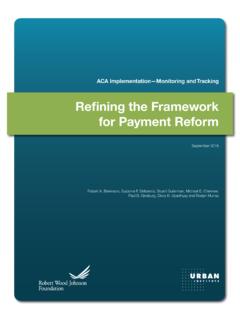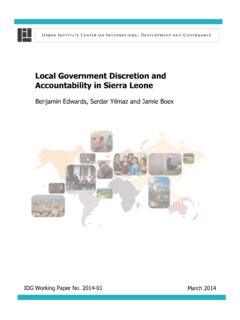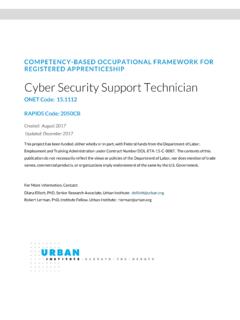Transcription of HOUSING FINANCEPOLICY CENTER COMMENTARY
1 1 HOUSING FINANCE POLICY CENTER COMMENTARY urban institute The Mortgage Forgiveness Debt Relief Act Has Expired Renewal Could Benefit Millions LAURIE GOODMAN AND ELLEN SEIDMAN Under the federal tax code, when a lender forgives part or all of a mortgage, the borrower must count that forgiveness as taxable income. Congress wisely recognized that this tax rule would discourage the forgiveness of debt as a tool to reduce foreclosures and add insult to injury for borrowers already struggling to pay their bills, many of whom had just lost their home. So in 2007, it passed the Mortgage Debt Forgiveness Act (the Act), which excludes this forgiveness from taxable income. On December 31, 2013, the Mortgage Forgiveness Debt Relief Act Unless Congress extends it, HOUSING debt that has been forgiven or written off after 2013 through short sales, foreclosures, or loan modifications that include principal forgiveness will generally be treated as taxable income.
2 A bill that would extend the Act for two years has been introduced by Representative Bill Foster (D-IL), and many analysts predict that the Act will eventually be renewed. In the meantime, however, uncertainty over its renewal has made it increasingly difficult for lenders and borrowers alike to take actions that will be beneficial to both parties. We calculate this uncertainty will affect up to 2 million borrowers who are seriously delinquent or in foreclosure, many of whom will lose their homes, and as many as million more who could potentially benefit from loan modifications that include principal reductions. The case for rapid resolution is made more poignant by the fact that failure to do so contradicts other public policy initiatives. Last July, the Department of the Treasury extended the Home Affordable Modification Program (HAMP) for two years, until year-end 2015.
3 HAMP loan modifications may include principal reduction, a technique that has proven especially effective in keeping homeowners in their homes. With the expiration of the Act, borrowers receiving principal reductions risk being taxed on the forgiven debt, sharply reducing the utility of the modification. Just as important, the large settlements between government regulators, lenders, and servicers are increasingly including commitments by institutions to provide significant sums of debt forgiveness. In the 2012 settlement between the State Attorneys General, the Department of Justice, and the nation s five largest lenders, $10 billion of the $25 billion settlement was set aside for principal forgiveness. The actions under this settlement have been substantially completed but it has set the template for others to follow.
4 In November 2013, JPMorgan Chase reached a $13 billion settlement with regulators over soured mortgage securities sold prior to the 2008 crisis; $4 billion of the settlement was set aside for consumer relief, which will take various forms, including principal reduction loan modifications. In December 2013, Ocwen reached a $ billion settlement, with $2 billion to be used for principal reduction modifications. We can expect to see a series of additional settlements in the coming year, with much of the restitution in the form of principal reduction. The timing of the expiration of the Mortgage Forgiveness Debt Relief Act is thus particularly unfortunate because it undermines the effectiveness of an increasingly utilized tool to reduce foreclosures. In this paper we describe the implications of the Act s expiration and call for its rapid reenactment.
5 HOUSING FINANCE POLICY CENTER COMMENTARY FEBRUARY 17, 2014 2 History of the Mortgage Forgiveness Debt Relief Act Generally, canceled or modified debt is treated as income that can be taxed by the government (hence the term, debt income ). However, this is not always the case; there are a number of exemptions: Debts discharged through bankruptcy Borrowers who are insolvent when their debt is canceled (a taxpayer is insolvent when total debts exceed the fair market value of assets) Certain farm debts Nonrecourse loans2 Between 2007 and December 31, 2013, Qualified Principal Residence Indebtedness, as provided in the Mortgage Forgiveness Debt Relief Act. The Act exempts from taxation debt canceled when a borrower loses a home through a short sale, deed-in-lieu, or foreclosure, and debt forgiven through a loan modification that includes principal The forgiven debt, however, must have been acquired in the purchase, building, or significant improvement of the borrower s principal residence, and the debt must be secured by that These rules raise some interesting tax policy questions.
6 The tax code treats debt forgiveness as income because a reduction in debt is equivalent to an increase in wealth. However, the tax code is very inconsistent in its treatment of income. Borrowers in recourse states who have taxable debt income because they have lost their home through short sales, deeds- in-lieu, or foreclosure are treated more harshly from a tax perspective than borrowers who sell their home in the normal course of life events. These borrowers can generally exclude the profit (capital gains) from the sale. Moreover, since nonrecourse mortgages are usually exempt, debt relief on most home mortgages in California is exempt from tax, while most relief provided in New York or New Jersey is taxable. This is obviously inequitable. Cancellation of Debt Has Been Widely Used to Provide Borrower Relief We can quantify how widely debt cancellation has been used to provide relief for borrowers who have lost their homes, as well as for borrowers who have been able to keep their homes through sustainable mortgage modifications.
7 More important, we can estimate how many borrowers could be affected going forward. Borrowers who have lost/will lose their homes Hope Now reports that million home liquidations (short sales, deeds-in-lieu, and foreclosures) occurred between the third quarter of 2007 and November 2013. Without the Act, many of these million households would have been hit by a large tax bill even after surrendering their homes. Although liquidations have slowed, the crisis is far from over. The National Delinquency Survey, conducted by the Mortgage Bankers Association (MBA), finds that million borrowers percent of sampled loans are either seriously delinquent or in foreclosure. The survey is based on a sample of million loans, which the MBA estimates represents 88 percent of all loans.
8 Assuming that the rest of the market has the same characteristics as the sampled portion, the total number of borrowers who are seriously delinquent or in foreclosure is actually closer to million. However, a portion of these borrowers live in nonrecourse states; for them, the debt extinguished on foreclosure is not Table 1 (based on MBA data) shows that million of the million loans in the MBA s sample, or percent of the loans, are in nonrecourse states. However, nonrecourse states have disproportionately fewer seriously delinquent or foreclosed loans; out of the million loans that are seriously delinquent or in foreclosure, only 550,000, or percent, are in nonrecourse states. Nonrecourse states tend to be nonjudicial states, which have made greater progress in clearing loans in serious delinquency or foreclosure.
9 For the entire country, percent of loans are in serious HOUSING FINANCE POLICY CENTER COMMENTARY FEBRUARY 17, 2014 3 delinquency or foreclosure; for nonrecourse states, it is percent of loans. Bottom line: More than 75 percent of loans that are seriously delinquent or in foreclosure are in states in which debt forgiveness would be subject to taxation. That affects approximately 2 million families. Without the protection provided by the Act, many of these borrowers stand to not only lose their homes, but also to face large tax bills. Borrowers receiving loan modifications There have been million loan modifications since the third quarter of 2007, approximately as many modifications as liquidations. Assessing the number of modifications that included principal reductions is difficult.
10 Principal reduction modifications are permitted on private label securities and bank portfolio loans, but not on loans insured by Fannie Mae or Freddie Mac (the GSEs) or government-insured loans. Modifications on private label and bank portfolio loans comprised percent of all modifications made in the third quarter of 2013. How many of these included principal reductions? The use of principal reduction is higher now than earlier in the crisis. The OCC Mortgage Metrics Report indicates that the share of all modifications that received principal reductions grew from percent in 2010 to a peak of percent in 2012, and then declined to percent by the third quarter of Earlier OCC Mortgage Metrics Reports show that from 2008 to late 2013, percent of total modifications were principal reductions, with more in the 2012 13 period than in the earlier years.









